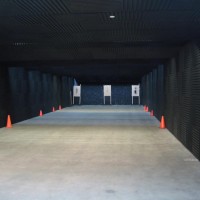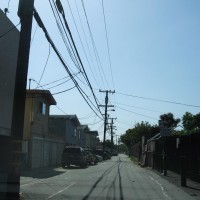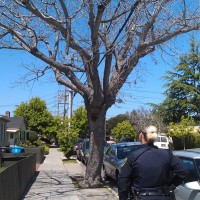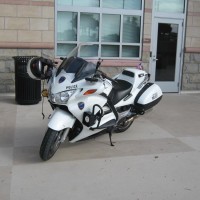
While out on patrol, Officer Von Glahn looks for any vehicle code violations, suspicious behavior, and anything out of the ordinary. This Sunday morning was off to a slow start.
Click here to see the photo gallery »
Sitting in a police cruiser usually means bad news, but last Sunday morning, I was the lucky exception. From the mundane to the suspenseful, my ride-along with Officer Nicole Von Glahn of the San Mateo police department provided a first-hand look into the work of law enforcement in our community.
My day began at 9 a.m. at the San Mateo Police Station. Though I have never had the fortune of staying in its jail, a quick walk-through convinced me I probably did not want to change that. After a peek at the dispatch center and the shooting range, we hit the road in Van Glahn’s cruiser.
This particular Sunday morning was off to a slow start, which is good news for residents and officers but not ideal for a budding journalist hoping for some interesting—but not too interesting—content.
A routine patrol through Van Glahn’s beat included downtown San Mateo and the alley behind the 700 block of N. Amphlett Boulevard, a block previously notorious for violence and gang activity. This served as a reminder of the dangerous situations that officers often encounter.
Some of this comes from the uncertainty of the job. Von Glahn says, “When you start your shift, you don’t know what you’re going to see or do that day. You could go to a homicide. Five minutes from then, you could be in a foot chase and fighting a suspect … or you could be sitting in your car driving around on a mundane day.”
Indeed, no one could have predicted what our first call would entail—a grown man running around Borel Avenue wearing only diapers. A concerned citizen had called police, and upon arrival, officers stopped the man and questioned him.
Officers learned that the man had previously suffered a medical incident and had him transported to the hospital via ambulance, but not before the man had defecated upon one unfortunate officer’s patrol car hood. The firemen on scene were none too happy to be the ones to hose it off the car.
Afterwards, Von Glahn drove up to Aragon, where I had the opportunity to ask her about the relationship between the police and schools.
In terms of incidents involving police on campus, Von Glahn says, “We typically will take a police report which is sent to Youth Services Bureau, and we work with the staff, the dean, or whoever else to try to get to the bottom of why this student is doing these things and try to fix their behavior or help them.”
She continues, “If it’s becoming a habit, then all those police reports are documented and sent to Hillcrest, and that student could potentially be put on juvenile court probation.”
Although law enforcement must deal with many negative aspects of society, Von Glahn stresses that people should not view them in a similar light.
“A lot of times when I’m out, say in the downtown area, I’ll see a father or mother with their child and they’ll say, ‘Uh-oh—there’s a police officer. they’re coming to get you,’ and I want to tell that mother or father ‘Don’t teach your children that. We’re not bad people.’ We’re here to help people,’” says Von Glahn.
She elaborates, “It’s not all business when I interact with kids. I try to be friendly with them, let them know I’m always there to help out if they need anything. But I think really [that] when law enforcement is dealing with children or juveniles, it should really try to stay on a positive upswing.”
Soon after our interview, a call came in about an assault in progress, and Von Glahn was determined to arrive on scene quickly. Never before have I sat in a vehicle going twice the speed limit in a school zone or driving on the wrong side of the rode in that context. Though admittedly thrilling, it was difficult to forget the seriousness of the situation.
Upon arrival, the subjects described had left and a frenzy of information flew over the radio. One difficult aspect of a police officer’s duties is determining fact from fiction. Conflicting suspect information slowed the search, and witness descriptions lacked the specificity necessary to pinpoint the individuals among the throngs of noontime downtown patrons.
After a sweep of the area turned up nothing, we moved on to the next call. A traumatized individual claimed to be a special victim and requested that police aid her in settling into San Mateo after just arriving. Without further information, Von Glahn could only provide this individual with directions to St. Vincent de Paul, which provides services to the homeless.
The last call of our ride-along involved a tree branch dangling from a tree over the sidewalk. A concerned citizen requested that police check out the situation, since the Public Works department is closed on Sundays.
“Being a police officer, you wear a lot of hats,” says Von Glahn. “Sometimes we’re marriage counselors. Sometimes we’re teachers. Sometimes we’re psychiatrists or psychologists. Sometimes we go to calls where we are telling somebody, giving them suggestions on how to raise their children.”
And other times, they have to be tree experts and structural engineers. Von Glahn determined that the branch had enough structural support from the tree to remain in place until Monday morning, when Public Works crews would arrive and resolve the hazard.
In the three-and-a-half hours that I spent riding-along with Officer Von Glahn, I was surprised at the breadth of experiences I had and derived a newfound respect for the wide range of tasks officers are called upon to perform, often without any prior preparation.
As for Von Glahn’s most memorable experience, she points to the time she saw someone lying on the railroad tracks during graveyard shift.
“He passed out on the railroad tracks,” says Von Glahn, “And I immediately jumped out of the car and grabbed him and pulled him off the tracks. He was so drunk that it was hard to tell if he was just drunk and passed out or if he was purposely doing that, so i got him the help that he needed, but that was memorable to me because if I hadn’t been driving by right then, who knows who would’ve seen him and if that would’ve been when the train came.”





















